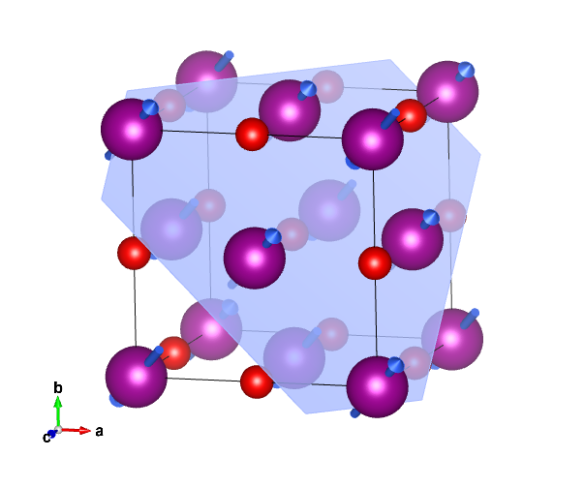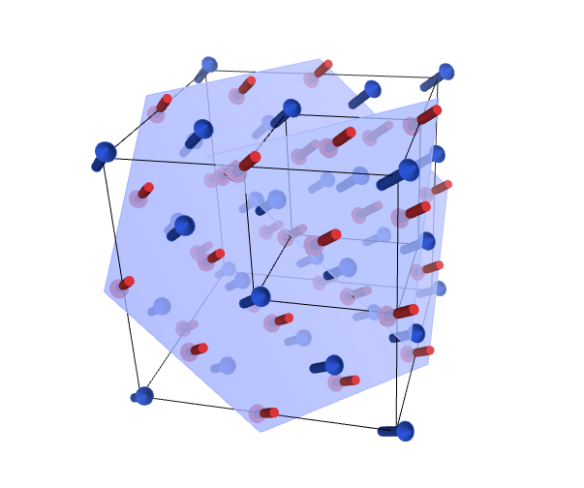Spins and Arrows: the Magnetic Story of MnO
What does it look like?

What is it?
It's manganese oxide or MnO, mineral name manganosite. Chemically, it's just a face-centred cubic structure structure like NaCl. The chemical structure was published in 1926.
But MnO doesn't just have a chemical structure, it also has a magnetic structure.
Many elements in the Periodic Table have a magnetic moment, which means that each atom acts like a tiny magnet with its own north and south pole. The arrows coming out of the manganese atoms in the image represent the direction of the moments - which way the north pole is pointing, if you like. The magnetic behavior of everyday objects - such as a magnet picking up iron filings - is due to the collective behavior of all these atoms.
Iron is an example of a ferromagnet. A typical lump of iron consists of a myriad of randomly oriented micron sized crystal grains (or domains). Within each grain the moments are lined up in the same direction. If you persuade enough of the domains to line up, you create a magnet.
By the end of the 1920s, physicists already had a reasonable understanding of ferromagnetism: it was one of Heisenberg's first applications of quantum mechanics. But some materials displayed magnetic behavior far from the ferromagnetic idea, and the French physicist Louis Néel suggested that the behavior could be explained if the magnetic moments alternate in direction – an antiferromagnet.
So given a hypothesis that explained the data, two more things were needed: a mechanism to explain how the manganese atoms could interact given there was an oxygen atom in the way, and some sort of independent direct evidence of the ordering. The mechanism of superexchange was suggested by H. A. Kramers, and later elucidated by P.W. Anderson: the electrons in the oxygen participate in the interaction.
The direct evidence was observed by Shull and Wollan in the early 1950s using the then new technique of neutron diffraction. The neutron has a spin, so it too is like a little magnet which interacts magnetically with the atom's magnetic moment. Because the manganese moments are arranged up-down-up, the magnetic unit cell is twice as big as the chemical unit cell. Shull and Wollan observed an extra diffraction peak at low temperatures not seen in the magnetically disordered room temperature structure.
Here's a picture of the structure again. This time, only the magnetic moments of the manganese are shown as blue and red arrows highlighting their alternate directions. The smaller cube shows the chemical unit cell. The larger cube shows the magnetic unit cell.

Magnetic crystallography is now a huge field in its own right. Louis Néel won the Nobel Prize for Physics in 1970 for his contributions to magnetism. Shull won the 1993 Physics Nobel for developing neutron diffraction. Anderson won the 1977 Physics Nobel for his contributions to solid state physics. Kramers died in 1952.
Where does it come from?
The chemical structure of MnO is #1010393 in the Crystallography Open Database. The figures were produced with VESTA.






